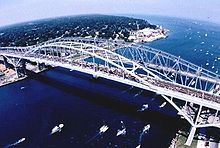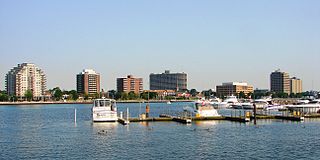
Sarnia is a city in Lambton County, Ontario, Canada. It had a 2021 population of 72,047, and is the largest city on Lake Huron. Sarnia is located on the eastern bank of the junction between the Upper and Lower Great Lakes, where Lake Huron flows into the St. Clair River in the Southwestern Ontario region, which forms the Canada–United States border, directly across from Port Huron, Michigan.

Walpole Island is an island and First Nation reserve in southwestern Ontario, Canada, on the border between Ontario and Michigan in the United States. It is located in the mouth of the Saint Clair River on Lake Saint Clair, about 121 kilometres (75 mi) by road from Windsor, Ontario, and 124 kilometres (77 mi) from Detroit, Michigan.
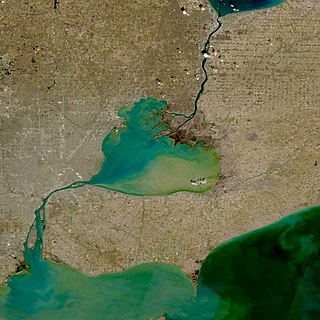
The St. Clair River is a 40.5-mile-long (65.2 km) river in central North America which flows from Lake Huron into Lake St. Clair, forming part of the international boundary between Canada and the United States and between the Canadian province of Ontario and the U.S. state of Michigan. The river is a significant component in the Great Lakes Waterway, whose shipping channels permit cargo vessels to travel between the upper and lower Great Lakes.

St. Clair is a township in southwestern Ontario, Canada, immediately south of Sarnia in Lambton County, along the eastern shores of the St. Clair River.

Point Edward is a village in the Canadian province of Ontario. Adjacent to the city of Sarnia in Lambton County, Point Edward sits opposite Port Huron, Michigan and is connected to it by the Blue Water Bridge, at the meeting point of the St. Clair River and Lake Huron. Formerly called Huron, it was renamed in 1860 to mark the visit by the then Prince of Wales, later Edward VII. It was incorporated in 1879. In the Canada 2016 Census, the population of Point Edward was 2,037, an increase of 0.1 percent from its 2011 population of 2,034.
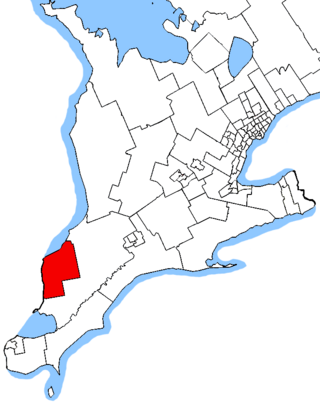
Sarnia—Lambton is a federal electoral district in Ontario, Canada, that has been represented in the House of Commons of Canada since 1968. It is located in the area of the city of Sarnia, in the southwest corner of the province of Ontario.
Lambton West was a federal electoral district represented in the House of Commons of Canada from 1883 to 1968. It was located in the province of Ontario. This riding was created from parts of Lambton riding.
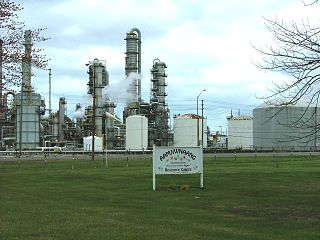
The Aamjiwnaang First Nation (Ojibwe: Aamjiwnaang Anishinaabek) is an Anishinaabe (Ojibwe) First Nations Band located on reserve land by the St. Clair River in Ontario, Canada, three miles south of the southern tip of Lake Huron. The reserve is located across from the United States border from Port Huron, Michigan, and is a result of treaties that were negotiated with the Crown in the 1820s. There are approximately 2,000 band members with about 650 living on the reserve. Their heritage language is Ojibwe.
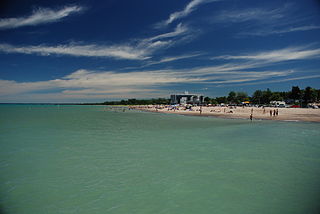
Lambton Shores is a municipality in Lambton County, Ontario, Canada, that is on the southern shores of Lake Huron.
The St. Clair Parkway, historically referred to as the River Road, is a scenic parkway in the Canadian province of Ontario. It travels alongside the St. Clair River from west of Wallaceburg to Sarnia, a distance of 41.8 kilometres (26.0 mi). It formed a portion of the route of Highway 40 until it was bypassed by an inland route that opened in the mid-1970s. The St. Clair River Parkway Commission maintained the route from 1966 until 2006, when it was disbanded and responsibility over the parkway transferred to Chatham-Kent and Lambton County, both of which designate the route as County Road 33. The communities of Port Lambton, Sombra, Courtright, Mooretown, Corunna and Froomfield are located along the parkway, all early settlements of the 19th century.

Plympton–Wyoming is a town in the Canadian province of Ontario, located in Lambton County immediately east of Sarnia. It is the seat of the Lambton County Council.
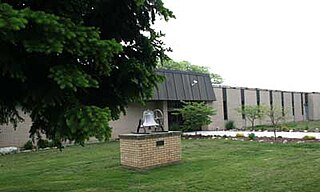
The Lambton Kent District School Board is the school board responsible for public education in Lambton County and Chatham-Kent, Ontario, Canada. Lambton and Kent Counties are made up of numerous small towns and communities situated in Southwestern Ontario, a geographic area surrounded by the Great Lakes.
King's Highway 21, commonly referred to as Highway 21, is a provincially maintained highway in the Canadian province of Ontario that begins at Highway 402 midway between Sarnia and London and ends at Highway 6, Highway 10 and Highway 26 in Owen Sound. The roadway is referred to as the Bluewater Highway because it remains very close to the eastern shoreline of Lake Huron.

Arkona is a community located in the municipality of Lambton Shores in southwestern Ontario near the Lambton–Middlesex county line, situated beside the Ausable River, on Former Kings Highway 79, Arkona is roughly halfway between Thedford, and Watford.

Warwick is a rural township in Lambton County, Ontario, Canada, with a population (2016) of 3,692.

Brooke-Alvinston is a township municipality in the Canadian province of Ontario, located within Lambton County. It was formed on January 1, 2001, when the Township of Brooke was amalgamated with the Village of Alvinston.
King's Highway 80, commonly referred to as Highway 80, was a provincially maintained highway in the Canadian province of Ontario. It travelled in an east–west direction south of Sarnia from Courtright to Strathburn. Beginning at the St. Clair Parkway near the shores of the St. Clair River, the route travelled 69.6 kilometres (43.2 mi), intersecting Highway 40, Highway 21 and Highway 79 before ending at Highway 2. In addition to the towns at either terminus, Highway 80 serviced the communities of Brigden, Glencoe and Alvinston. The entire route was and remains two lanes wide.
Elections were held in Lambton County, Ontario on October 22, 2018 in conjunction with municipal elections across the province.

Corunna is an unincorporated community in St. Clair Township, Lambton County, Ontario, Canada. The site of the community was surveyed by William Beresford in 1823. The community is located approximately 13 kilometres (8.1 mi) south of Sarnia. The community experienced a significant population boom between the 1830s and 1850s, mainly attributed to Scotch-Irish immigration. The community serves as the location of Chemical Valley, a major petrochemical and plastics manufacturing facility.
Elections were held in Lambton County, Ontario on October 24, 2022, in conjunction with municipal elections across the province.




